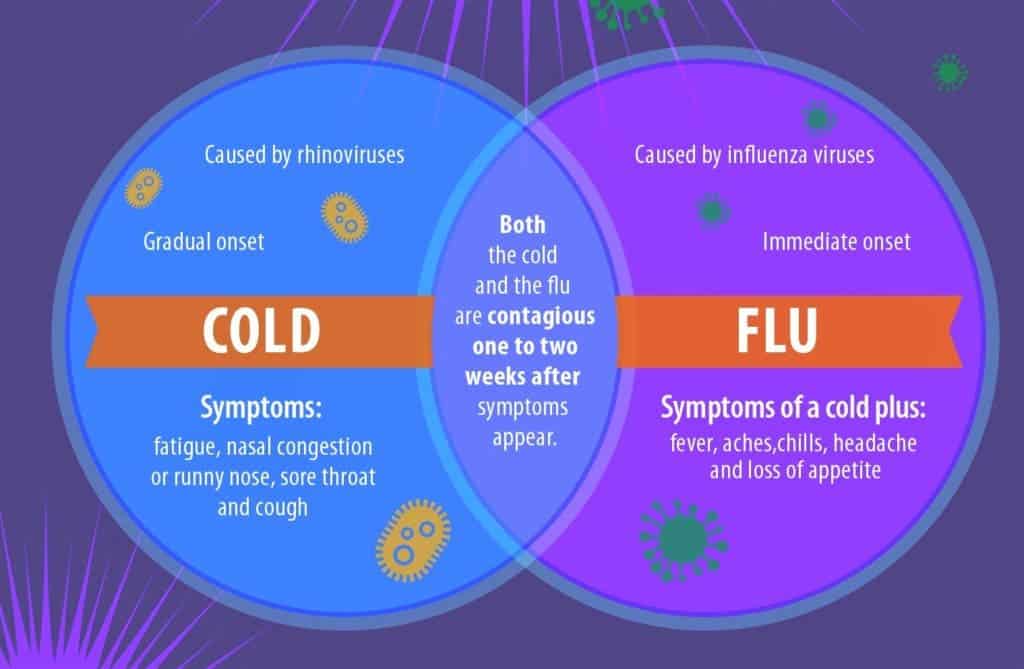
Flu and the common cold are both respiratory illnesses, but they are caused by different viruses. It can be difficult to tell the difference between them based on symptoms alone because they have similar symptoms. In general, colds are usually milder than flu and are more likely to have a runny or stuffy nose while influenza (the flu) can have very serious associated complications.

A new study by scientists from the Medical Research Council-University of Glasgow Centre for Virus Research found that people were less likely to catch either influenza or a common cold-causing rhinovirus if they were already infected with the other virus. Understanding how these distinct viruses hinder each other could be useful to improve forecasting models that predict respiratory disease outbreaks and strategies for controlling disease spread.
It has been observed before that common cold infections appear to be less frequent in the influenza season and vice versa. The study, published in the journal Proceedings of the National Academy of Sciences, is the first study with enough samples to provide strong evidence for this interaction at both the population and individual level.
Samples from 44,230 cases of acute respiratory illness, in 36,157 patients, were tested for 11 types of respiratory viruses over nine years in NHS Greater Glasgow and Clyde. Using this data, the researchers found that 35% tested positive for a virus and, of those, 8% were co-infected with more than one type of virus. The study looked at how 11 viruses interacted and found relationships between some of the other virus pairs, but these were not consistent at both the individual host and population level, which the study did find for influenza A and rhinovirus.
The most striking interaction they found was between influenza A viruses and rhinoviruses, a type of virus that can cause the common cold. Computer modeling of the data found that the inhibitory interactions between influenza and rhinoviruses appeared to occur within individual people as well as at a population level. Patients with influenza A were approximately 70% less likely to also be infected with rhinovirus than were patients infected with the other virus types.
The first author of the paper, Dr Sema Nickbakhsh from MRC-University of Glasgow Centre for Virus Research at the University of Glasgow, said: “One really striking pattern in our data is the decline in cases of the respiratory virus rhinovirus, which is typically a mild common cold-causing virus, occurring during winter, around the time that flu activity increases. In the same way as lions and spotted hyenas compete for food resources in the Masai Mara, we believe respiratory viruses may be competing for resources in the respiratory tract. There are various possibilities we’re investigating, such as these viruses are competing for cells to infect in the body, or the immune response to one virus makes it harder for another unrelated virus to infect the same person.”
Viruses from the same species – for example, different strains of influenza – could be expected to compete or generate an overlapping immune response in the body, but the researchers say what makes these findings interesting is the interaction between completely different types of viruses.
Dr Pablo Murcia, who led the research, said: “Traditionally people have studied viruses in isolation – you study only flu or rhinovirus – but we’ve shown here that we need to also be studying these viruses together like it’s an ecosystem. My team are now doing experiments to try and understand how respiratory viruses, including influenza and rhinovirus, interact. If we understand how viruses interact and how certain viral infections may favor or inhibit each other, then maybe we can develop better ways to target viruses. Studying interactions between viruses could help to explain why different viruses circulate in different seasons or why they affect different age groups, and within the body why certain types of viruses infect different parts of the respiratory tract, like the nose or the lungs.”
An example of how these viruses could also affect each other’s spread at a population level is the scenario where a person infected with one virus is more likely to stay home and consequently not catch another virus. Limitations of the study include: 1) the correlations observed cannot show what is causing these interactions and 2) samples were only taken from people with symptoms of a respiratory infection, so it may not capture how the viruses behave in people who do not develop symptoms.









